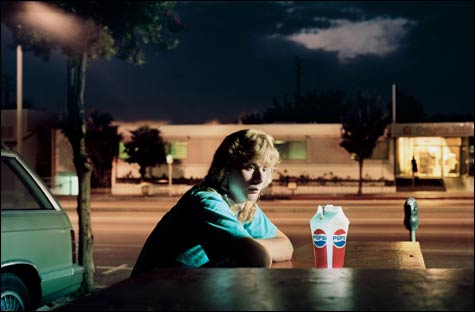VIDEO: Watch a tour of the 'Philip-Lorca diCorcia' exhibit at the ICA.
|
Photographer Philip-Lorca diCorcia, whose retrospective opened at the Institute of Contemporary Art last week, is a safe, easy choice for the new ICA’s first big artist retrospective. This New Yorker comes with art-world seals of approval (1993 Museum of Modern Art solo survey; 1997 Whitney Biennial) and powerhouse gallery representation (Pace/MacGill; Gagosian). He has New England ties (born in Hartford in 1951; bachelor’s degree from Boston’s Museum School in 1975) and ICA connections (he was included in the 1995 exhibition that named “Boston School” photography). Organized by Bennett Simpson, who left the ICA in January to join the Los Angeles Museum of Contemporary Art, the current 125-photo exhibit seems a signal from ICA leaders that theirs is a big-league institution that inscribes mid-career artists into the canon. But nobody’s taking any risks.
When diCorcia started out, photography was still dominated by what French photojournalist Henri Cartier-Bresson called the “decisive moment.” This was the idea that great photography is a sort of athletic-intellectual gymnastics in which photographers stalk subjects, finagle to be at the right place at the right time, and in a split-second focus and compose their picture to epitomize the moment, the subject, the height of the action.
Inspired by conceptual art and early postmodernism, diCorcia broke apart this idea. Between 1978 and 1990, he staged slice-of-life scenes with posed family members and friends. His artifice questioned authenticity in life as well as in photography. And it allowed him to try out the pictorial invention of old-master painting. But the staging isn’t readily apparent — because of diCorcia’s artistry, and because the scenes are often so banal. A woman floats on an inflatable mattress in a pond, a man stares at a wall above a jukebox, a woman lies on a couch watching television while a robed man snaps a photo. In Mario (1978), a man — one of diCorcia’s brothers — stares dully into a refrigerator. His gaze and the lights rigged inside the fridge and on the counter opposite suggest a story about a dreary night, a dreary life. “It seemed to me that the power to affect people always involved some psychological engagement,” diCorcia says in the ICA’s exhibition catalogue. Edward Hopper played the same game, but whereas his paintings overflow with narrative leads, diCorcia’s hints are all dead ends. What you see is what you get.
DiCorcia in this period is often compared with Jeff Wall, Cindy Sherman, and Gregory Crewdson, other photographers who stage elaborate scenes. His work has some of the same magic, and it suffers from some of the same soullessness. What sets him apart is the way he plays in documentary territory but projects his ideas onto his subjects. For his Hustlers series (1990-’92), he picked out locations and set up his camera and lights before he drove out to hire prostitutes to play prostitutes in his invented scenarios. A hard-looking dude with his hair slicked back sits next to a sign for a taco joint. A buff topless guy stands between cars in a supermarket parking lot at dusk. In what could be an outtake from the 1969 film Midnight Cowboy, a prostitute lies sprawled in the middle of a sidewalk, atop John Lennon’s star on the Hollywood Walk of Fame, as a Greyhound bus passes behind him. This isn’t a documentary about prostitutes — it’s a documentary about Hollywood myths of prostitutes. Underneath lie questions about selling images and fantasies, in art and in life.

BRENT BOOTH, 21 YEARS OLD, DES MOINES, IOWA, $30 (1990-’92): Prostitutes or Hollywood
myths of prostitutes?
|
In diCorcia’s Streetwork photos (1993-’99), he rigged sidewalk posts with lights, set up his camera on a waist-high tripod, and waited for unsuspecting pedestrians to walk into his frame. In one, a stubbly beggar, with his eyes covered, reaches out his hand as if feeling his way down a New York street. A couple of guys stand around twin phone booths watching him; others seem lost in their own world. A man with a microphone could be a street preacher. Is it just coincidence that an advertisement on the phone booth reads “legendary days”? Everything suggests a “decisive moment” is about to occur, but the more you ponder what’s going on, the more all meaning evaporates.
For Heads (2001), diCorcia rigged lights underneath scaffolding in New York’s Times Square and photographed pedestrians with a telephoto lens from some 20 feet away. The technique caused daylight to drop out, making it appear to be night or a studio shot. He edited down a few thousand images to 17 detailed head-and-shoulder portraits: an elderly bearded Hassidic man with a wrinkled brow, a pimply boy in a Yankees cap, a security guard whose eyes disappear into shadows. A teenage girl smiles, her hair blown up as if in some shampoo commercial. The closeness and the detail suggest intimacy, but we’re shut out of these lives.